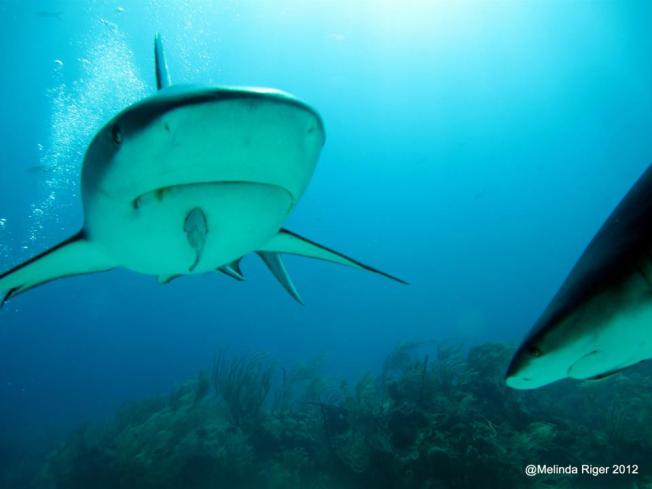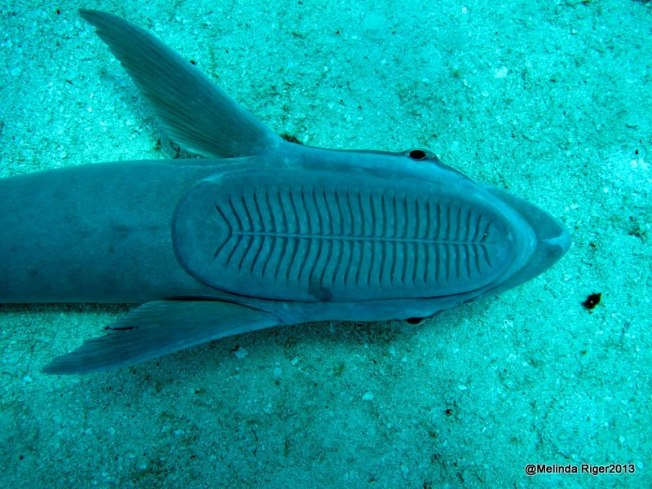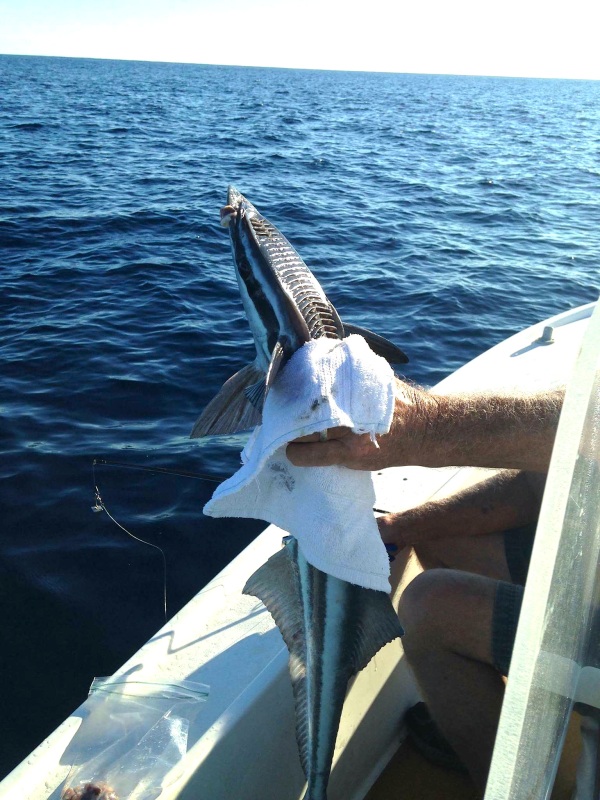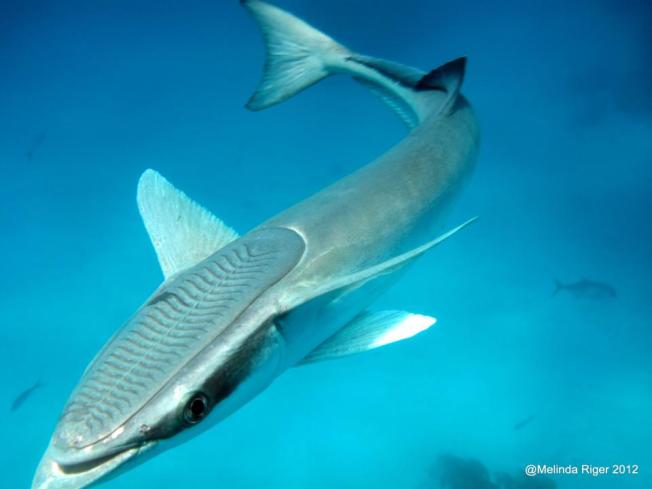
WTF? (WHAT’S THAT FISH?) REMORAS: WEIRD SUCKERS
WHAT ON EARTH ARE REMORAS?
Remoras (Echeneidae), also known as Sharksuckers, Whalesuckers or Suckerfishes, are ray-finned fish that grow up to 3 feet long. 
You may have noticed them in pictures of sharks and wondered briefly why they hang out with such dangerous creatures. There is filmed evidence that remoras do occasionally get eaten by their hosts…
WHAT DO THEY DO?
Remoras have remarkable dorsal fins that form a sucker-like organ with a ribbed structure. It looks a bit like the sole of a trainer or beach shoe. This bizarre organ can open and close to create or release suction, enabling it can latch onto larger marine creatures. The remora can increase suction by sliding backward, or it can release itself by swimming forward – the ‘slats’ are smooth in one direction, and rough the other way. They have been known to attach themselves to boats. And scuba divers. Even with hairy legs…
This bizarre organ can open and close to create or release suction, enabling it can latch onto larger marine creatures. The remora can increase suction by sliding backward, or it can release itself by swimming forward – the ‘slats’ are smooth in one direction, and rough the other way. They have been known to attach themselves to boats. And scuba divers. Even with hairy legs…
WHAT KIND OF CREATURES DO THEY GET ATTACHED TO?
Remoras associate with specific host species. They commonly attach themselves to sharks, manta rays, whales, turtles, and manatees / dugongs. Smaller remoras may latch onto fish such as tuna and swordfish, and some travel in the mouths or gills of large manta rays, ocean sunfish, swordfish, and sailfish.

WHY WOULD THEY WANT TO DO THAT?
The relationship between a remora and its host is known as Commensalism, specifically ‘Phoresy‘. The host to which it attaches for transport gains nothing from the relationship, but also loses little. The remora benefits by using the host as transport and protection, and also feeds on morsels dropped by the host. Controversy surrounds whether a remora’s diet is primarily leftover fragments, or the feces of the host. Maybe it’s a healthy mix of both.
WHERE CAN I FIND ONE?
Remoras are found in tropical, sub-tropical and temperate waters, including the mediterranean. You will definitely find them in the Bahamas. Melinda’s photos were all taken in the waters south of Grand Bahama.
CAN YOU CATCH ONE?
YES! This late addition (Nov 2016) comes courtesy of Cinda Parks… a remora caught in Cherokee Sound. It’s the first image of a live one out of the water that I’ve come across!
ARE THEY USEFUL TO MANKIND IN ANY WAY?
Yes, but not in a good way, some may think. Some cultures use remoras to catch turtles. A cord or rope is fastened to the remora’s tail, and when a turtle is sighted, the fish is released from the boat; it usually heads directly for the turtle and fastens itself to the turtle’s shell, and then both remora and turtle are hauled in. Smaller turtles can be pulled completely into the boat by this method, while larger ones are hauled within harpooning range. This practice has been reported throughout the Indian Ocean, especially from eastern Africa near Zanzibar and Mozambique, from northern Australia, Japan and even the Americas.
Because of the shape of the jaws, appearance of the sucker, and coloration of the remora, it sometimes appears to be swimming upside down (see above). This probably led to an older name reversus, although this might also derive from the fact that the remora frequently attaches itself to the tops of manta rays or other fish, so that the remora is upside down while attached.
THANKS FOR THAT. BUT WHERE CAN I GET MORE INFO ON THESE SUCKERS?
RIGHT HERE – AN EXCELLENT VIDEO WITH PLENTY OF LIVE REMORA ACTION
OH! FINAL QUESTION. ARE REMORAS EDIBLE?
I though someone might ask that, so I’ve checked it out. Here is the best recipe I have found, expanded slightly from a blokey Australian chat thread:
Recipe for cooking Remora
- put a 12 ltr pot on to boil
- when the pot is bubbling violently, add 2 whole remora, 2 garden rocks, 1 carrot & a large turnip
- add grandfather’s boots to taste, and turn heat down after 3 hours
- simmer for a further 6 hours
- turn off heat and drain carefully
- remove and discard remora, and serve the rest on a bed of tin tacks
Credits: Melinda Riger, Grand Bahama Scuba; Cinda Parks for the freshly caught remora 2016; Wikimedia; meaty Wiki chunks & assorted pickings




I survived 3 remora attacks TODAY off Treasure Cay! Very unnerving!! Hysterical scene at the beach, I caused!! I couldn’t shake it off!!
LikeLike
Hi Jessica, thanks for your ‘Close Encounters of the Weird Kind’news. How far out from the beach were you I wonder? It’s never happened to me, but I think you kind of smack them to dislodge them. Just be thankful they aren’t like leeches… RH
LikeLike
Great post, I was thinking that the turtle wouldn’t provide a fast transit system . . . lol, but then I’m sure they’re have better mobility in the water!
LikeLike
I think remoras would abandon ship before a turtle waddled clumsily out of the water. In the water, it’s a different matter. Turtles are very strong swimmers, and may have an astonishing turn of speed from ‘resting and mooching about underwater’ to ‘zoooooooom’ in an instant, at least over a short distance. A remora might even fall off! RH
LikeLike
New comment on your post “WTF? (WHAT’S THAT FISH?) REMORAS: WEIRD SUCKERS”
Author : Capt Rick Guest
Comment:
RH;They also unnervingly, abruptly attach to skin divers! I and my diving pals have had considerable “hickeys” left behind. This often times in the Bahamas.
Reply:
That must be quite a surprise when it happens! I assume the suction is quite strong. Do you have to pull them backwards to get them off again? Or do you just do anything that will get them off you? All the best, RH
LikeLike
laughing….they are weird suckers!!!
LikeLike
A gift for the jokey tagline, Cindy! RH
LikeLike
Since ones startled reaction is to bat it away, this is usually all it takes to dislodge the creature,since they’re not used to being handled. They will continue to hound us for awhile. One useful method is to get close enough to another diver so as to “share the joy”
LikeLike
A canny ploy, Rick. Except they are presumably doing the same to you… ‘pass the remora’! 😎
LikeLike
I think you need to put that recipe to good use and report back RH – I hope that the shoe sole doesn’t make the meal too rubbery!
LikeLike
Lack of available grandfathers and absence of inherited boots will make the recipe somewhat anaemic, I think. I may have to leave it. RH
LikeLike
If that’s the only problem I’d be very happy to send you my boots once they’ve worn out! They have, after all, spent much of their time at the coast and you will get a true sea salt seasoning out of them!!!
LikeLike
A very kind offer. I have a feeling that well-worn trainers might also have a benign flavouring effect. Compared with the fish, that is. RH
LikeLike
What bizarre creatures RH. I like the recipe at the end… I’ve read a similar one for pike!
LikeLike
Very odd indeed. Nothing like that in the Wey, I’ll be bound. There’s a great protracted recipe for cormorant, involving burying it in a sack for 6 months…
LikeLike